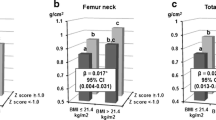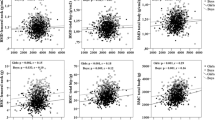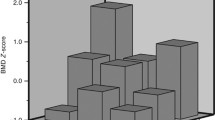Abstract
We conducted a cross-sectional study in a cohort of Japanese adolescent schoolgirls (12–18 years of age) and their mothers (387 pairs). Age, lumbar bone mineral density (BMD), birth and menarche-related status, height, body weight and lifestyles were surveyed in the participants. The values of BMD, height and body weight were converted to standard deviation (SD) by age. There were 49 (12.7%) pre-menarche and 338 (87.3%) post-menarche daughters. BMD-SD, height-SD, vitamin D intake and vitamin K intake were significantly correlated between the pre-menarche daughters and mothers (P < 0.05), while BMD-SD, birth weight, age at menarche and all lifestyle-related factors were significantly correlated between the post-menarche daughters and mothers (P < 0.05). BMD-SD in the pre-menarche daughters was affected by BMD-SD in mothers (R 2 = 0.069, P = 0.033) and their own height-SD (R 2 = 0.199, P = 0.001) (model R 2 = 0.340), independently. BMD-SD in the post-menarche daughters was affected by BMD-SD in mothers (R 2 = 0.073, P < 0.001) as well as by their own age at menarche (R 2 = 0.020, P = 0.001), height-SD (R 2 = 0.022, P < 0.001), body weight-SD (R 2 = 0.081, P < 0.001) and intensity of exercise (R 2 = 0.015, P = 0.045) (model R 2 = 0.372), independently. The results suggest that BMD is strongly correlated between daughters and mothers and that a greater age at menarche leads to lower peak bone mass. It was also suggested that maintaining high-intensity physical activity and adequate body weight is important in achieving maximum BMD as factors amenable to intervention in post-menarche daughters.


Similar content being viewed by others
References
NIH Consensus Development Panel on Osteoporosis Prevention, Diagnosis, and Therapy (2001) Osteoporosis prevention, diagnosis, and therapy. JAMA 285:785–795
Oleksik A, Lips P, Dawson A, Minshall ME, Shen W et al (2000) Health-related quality of life in postmenopausal women with low BMD with or without prevalent vertebral fractures. J Bone Miner Res 15:1384–1392
Kanis JA, McCloskey EV (1992) Epidemiology of vertebral osteoporosis. Bone 13(Suppl 2):S1–S10
Center JR, Nguyen TV, Schneider D, Sambrook PN, Eisman JA (1999) Mortality after all major types of osteoporotic fracture in men and women: an observational study. Lancet 353:878–882
Bonjour JP, Theintz G, Buchs B, Slosman D, Rizzoli R (1991) Critical years and stages of puberty for spinal and femoral bone mass accumulation during adolescence. J Clin Endocrinol Metab 73:555–563
Hansen MA, Overgaard K, Riis BJ, Christiansen C et al (1991) Role of peak bone mass and bone loss in postmenopausal osteoporosis: 12 year study. BMJ 303:961–964
Takahashi Y, Minamitani K, Kobayashi Y, Minagawa M, Yasuda T et al (1996) Spinal and femoral bone mass accumulation during normal adolescence: comparison with female patients with sexual precocity and with hypogonadism. J Clin Endocrinol Metab 81:1248–1253
Sabatier JP, Guaydier-Souquières G, Benmalek A, Marcelli C (1999) Evolution of lumbar bone mineral content during adolescence and adulthood: a longitudinal study in 395 healthy females 10–24 years of age and 206 premenopausal women. Osteoporos Int 9:476–482
Southard RN, Morris JD, Mahan JD, Hayes JR, Torch MA et al (1991) Bone mass in healthy children: measurement with quantitative DXA. Radiology 179:735–738
Eastell R, Lambert H (2002) Diet and healthy bones. Calcif Tissue Int 70:400–404
Ondrak KS, Morgan DW (2007) Physical activity, calcium intake and bone health in children and adolescents. Sports Med 37:587–600
Ruiz JC, Mandel C, Garabedian M (1995) Influence of spontaneous calcium intake and physical exercise on the vertebral and femoral bone mineral density of children and adolescents. J Bone Miner Res 10:675–682
Zhu K, Du X, Greenfield H, Zhang Q, Ma G et al (2004) Bone mass in Chinese premenarcheal girls: the roles of body composition, calcium intake and physical activity. Br J Nutr 92:985–993
Lee WT, Leung SS, Ng MY, Wang SF, Xu YC et al (1993) Bone mineral content of two populations of Chinese children with different calcium intakes. Bone Miner 23:195–206
Mølgaard C, Thomsen BL, Michaelsen KF (2001) The influence of calcium intake and physical activity on bone mineral content and bone size in healthy children and adolescents. Osteoporos Int 12:887–894
Bradney M, Pearce G, Naughton G, Sullivan C, Bass S, Seeman E et al (1998) Moderate exercise during growth in prepubertal boys: changes in bone mass, size, volumetric density, and bone strength: a controlled prospective study. J Bone Miner Res 13:1814–1821
McKay HA, Petit MA, Schutz RW, Prior JC, Barr SI, Khan KM et al (2000) Augmented trochanteric bone mineral density after modified physical education classes: a randomized school-based exercise intervention study in prepubescent and early pubescent children. J Pediatr 136:156–162
Bakker I, Twisk JW, Van Mechelen W, Roos JC, Kemper HC (2003) Ten-year longitudinal relationship between physical activity and lumbar bone mass in (young) adults. J Bone Miner Res 18:325–332
Courteix D, Jaffré C, Lespessailles E, Benhamou L (2005) Cumulative effects of calcium supplementation and physical activity on bone accretion in premenarchal children: a double-blind randomised placebo-controlled trial. Int J Sports Med 26:332–338
Krall EA, Dawson-Hughes B (1993) Heritable and life-style determinants of bone mineral density. J Bone Miner Res 8:1–9
Runyan SM, Stadler DD, Bainbridge CN, Miller SC, Moyer-Mileur LJ (2003) Familial resemblance of bone mineralization, calcium intake, and physical activity in early-adolescent daughters, their mothers, and maternal grandmothers. J Am Diet Assoc 103:1320–1325
Sasaki S, Yanagibori R, Amano K (1998) Self-administered diet history questionnaire developed for health education: a relative validation of the test-version by comparison with 3-day diet record in women. J Epidemiol 8:203–215
Sasaki S, Ushio F, Amano K, Morihara M, Todoriki O et al (2000) Serum biomarker-based validation of a self-administered diet history questionnaire for Japanese subjects. J Nutr Sci Vitaminol 46:285–296
Barr SI, McKay HA (1998) Nutrition, exercise, and bone status in youth. Int J Sport Nutrition 8:124–142
Obermayer-Pietsch B (2006) Genetics of osteoporosis. Wien Med Wochenschr 156(5–6):162–167
Heaney RP, Abrams S, Dawson-Hughes B, Looker A, Marcus R et al (2000) Peak bone mass. Osteoporos Int 11:985–1009
Ferrari S, Rizzoli R, Slosman D, Bonjour JP (1998) Familial resemblance for bone mineral mass is expressed before puberty. J Clin Endocrinol Metab 83:358–361
Jouanny P, Guillemin F, Kuntz C, Jeandel C, Pourel J (1995) Environmental and genetic factors affecting bone mass. Arthritis Rheum 38:61–67
Margarey AM, Boulton TJC, Chatterton BE, Schultz C, Nordin BEC (1999) Familial and environmental influences on bone growth from 11–17 years. Acta Paediatr 88:1204–1210
Bounds W, Skinner J, Carruth BR, Ziegler P (2005) The relationship of dietary and lifestyle factors to bone mineral indexes in children. J Am Diet Assoc 105:735–741
Rubin K, Schiruan V, Gendreau P, Sarfarazi M, Mendola R et al (1993) Predictors of axial and peripheral bone mineral density in healthy children and adolescents, with special attention to the role of puberty. J Pediatr 123:863–870
Kelly PJ, Eisman JA, Sambrook PN (1990) Interaction of genetic and environmental influences on peak bone density. Osteoporos Int 1:56–60
Acknowledgment
This work was partly supported by a grant-in-aid from the Japan Osteoporosis Foundation.
Author information
Authors and Affiliations
Corresponding author
About this article
Cite this article
Kuroda, T., Onoe, Y., Miyabara, Y. et al. Influence of maternal genetic and lifestyle factors on bone mineral density in adolescent daughters: a cohort study in 387 Japanese daughter-mother pairs. J Bone Miner Metab 27, 379–385 (2009). https://doi.org/10.1007/s00774-009-0045-y
Received:
Accepted:
Published:
Issue Date:
DOI: https://doi.org/10.1007/s00774-009-0045-y




